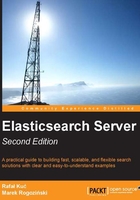
What this book covers
Chapter 1, Getting Started with the Elasticsearch Cluster, covers what full-text searching, Apache Lucene, and text analysis are, how to run and configure Elasticsearch, and finally, how to index and search your data in the most basic way.
Chapter 2, Indexing Your Data, shows how indexing works, how to prepare an index structure and what data types we are allowed to use, how to speed up indexing, what segments are, how merging works, and what routing is.
Chapter 3, Searching Your Data, introduces the full-text search capabilities of Elasticsearch by discussing how to query, how the querying process works, and what type of basic and compound queries are available. In addition to this, we will learn how to filter our results, use highlighting, and modify the sorting of returned results.
Chapter 4, Extending Your Index Structure, discusses how to index more complex data structures. We will learn how to index tree-like data types, index data with relationships between documents, and modify the structure of an index.
Chapter 5, Make Your Search Better, covers Apache Lucene scoring and how to influence it in Elasticsearch, the scripting capabilities of Elasticsearch, and language analysis.
Chapter 6, Beyond Full-text Searching, shows the details of the aggregation framework functionality, faceting, and how to implement spellchecking and autocomplete using Elasticsearch. In addition to this, readers will learn how to index binary files, work with geospatial data, and efficiently process large datasets.
Chapter 7, Elasticsearch Cluster in Detail, discusses the nodes discovery mechanism, recovery and gateway Elasticsearch modules, templates and cluster preparation for high indexing, and querying use cases.
Chapter 8, Administrating Your Cluster, covers the Elasticsearch backup functionality, cluster monitoring, rebalancing, and moving shards. In addition to this, you will learn how to use the warm-up functionality, work with aliases, install plugins, and update cluster settings with the update API.